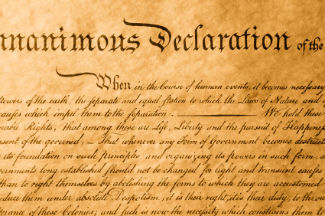 Since declarative sentences are the most common sentence type found in literature, usually students quickly grasp their purpose and function. Declarative sentences make a statement or provide a fact. They always end in period. Seems pretty simple, right?
Since declarative sentences are the most common sentence type found in literature, usually students quickly grasp their purpose and function. Declarative sentences make a statement or provide a fact. They always end in period. Seems pretty simple, right?
When teaching students about declarative sentences, teachers may want to share few examples similar to these:
The Grand Canyon is magnificent. (Statement)
I would like to visit the Grand Canyon. (Statement)
The Colorado River runs through the bottom of the Grand Canyon. (Fact)
The Grand Canyon is located in the state of Arizona. (Fact)
Here’s another idea to reinforce the concept. Elementary students have heard of the Declaration of Independence, a document drafted to formally state, or official proclaim independence from Britain. Teachers can explain to students that from a language arts perspective, it’s simply a document loaded with declarative sentences!
Games/Activities for teaching declarative sentences
Though declarative sentences are the most common and students usually have an easy time identifying them, a careful review and check for mastery is important. Sometimes students simply look for a period at the end of a sentence to determine if it is declarative. However, this isn’t a sound strategy because imperative sentences can end with a period as well.
Here is are two fun games/activities elementary students will enjoy that provide plenty of practice for formulating and identifying declarative sentences.
“Social” BINGO
This learning game is a teacher-tested and approved game loosely based on the widely popular BINGO. Social Bingo is commonly used as an icebreaker at the beginning of the school year and allows students to get to know their classmates. However, teachers can easily adapt it as a tool to teach declarative sentences.
The Bingo card is a sheet of paper with a 5×5 table for a total of 25 squares. Inside the 25 squares are descriptors such as “Has a pet reptile” or “Was born in February.”
The teacher should try to include a mix of fairly common descriptors and uncommon ones as well.
Each student receives a BINGO card. Explain to students they have 10-15 minutes to mingle with their classmates and try to find a student (or teacher!) that matches the descriptor. Instead of simply writing the corresponding student name in the descriptor box, students have to write a detailed declarative statement.
Examples:
Incorrect: Rob has a pet reptile.
Correct: Rob has a pet iguana named Iggy.
Incorrect: Katie was born in February.
Correct: Katie was born on February 15, 2002, the day after Valentine’s Day.
The first student to correctly fill a row of 5 squares across, down, or diagonally is the winner. However, most students will want to continue to play and since the goal is to practice writing declarative sentences, the game isn’t over until all squares are filled.
Teachers may want to post the BINGO cards on the wall so students can learn even more about their classmates from cards other than there own.
Fun Facts Book
In this activity, students use declarative sentences to compose a Fun Facts Book. The topic can be a subject studied in Science, such as the solar system or mammals. Or students can be allowed to choose their own topic such as a hobby or any activity they enjoy. Depending on how much time teachers want to allot to this activity, students can add colorful illustrations to illustrate their facts or create an attractive cover design.
Adaptations:
An extension of this game is to have students create another BINGO card but they must think of different descriptors and write them as an interrogative sentence. As before, the students mingle with each other to fill all the Bingo squares with declarative sentences.